-
Tuesday 1st February 2011
We arrived in Dominica last Saturday, and fell in love with it almost instantly. The sandy shores, the colourful canoes and the quaint little brightly painted houses that dot the sea shore. Even the dark skinned, white teethed smiling locals were a pleasure to talk to. Standing out in the predominantly dark skinned crowd as only “Whities” can, we'd always get the “Hello Mon – Are you Having Fun” or “”Hello Mon - How do you like my Dominica?” These weren't phrases to entice us into buying something, but came with a genuine smile and from the heart.
Dominica, or in particular Portsmouth has been the gem of the Caribbean. Despite a number of warnings about security and theft, we decided to go anyway and are so glad we did. The island is a beautiful, lush tropical place that is everything we imagined the Caribbean to be.
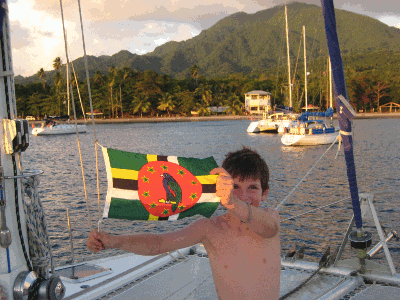
Even the check in procedure was easy. One of the boat boys took me over to the customs house and had me cleared into the country in less than 15minutes. Here, in order to accommodate the cruising yacht, customs clears you in with a 14 day visa and you are cleared out at the same time. This saves a trip back to customs before you leave. If you want to stay more than 14 days, then you only need go to immigration and fill in their forms and you can stay for the full 90 days.
Dominica, while having had a bad rap in the past with high levels of crime, drug problems and even a few assaults on cruising yachts, has been avoided by many cruisers. Dominica is now trying really hard to encourage tourism in their country and is making a concerted effort to help visitors enjoy their stay. Never have I heard a customs man say “We will do everything we can to clear you in easily so that you enjoy your stay – please tell your friends if you like Dominica” This was repeated many times from many islanders and they all went out of their way to ensure we enjoyed ourselves.
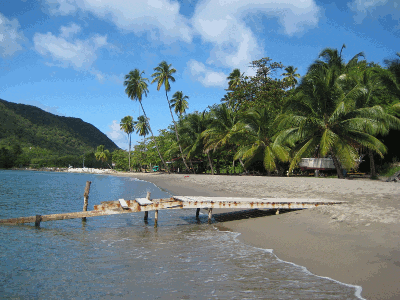
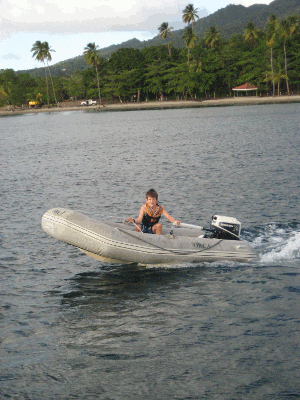
Dominica has an interesting history. Sadly like all the Caribbean islands, it feel to European settlement. The original islanders were the Carib Indians; a fierce group of warriors who pre-dated the Europeans and made life very hard for those trying to conquer their island. The Carib Indians called the island “Waitikubuli” which means “Tall is her Body” and were still living on the island when European settlers colonized the other islands. One of the big hazards facing the the settlers was Carib raiding parties who made life generally hard for the settlers. Sadly, as was the case with all the other islands, history was against them and the colonies flourished. Slowly the Caribs started trading with the Europeans and even started making friends with the missionaries. War parties took a heavy toll on the Carib Indian numbers as did the curious events surrounding “Indian Warner”. Warner was the son of the English governor of St Kitts, and his mother was a Carib slave from Dominica. He was brought up with the other sons, but when his father died, his stepmother persecuted him, so he fled back to Dominica's leeward coast where he became a chief. He remained on good terms with his half brother, Phillip Warner, and did several
services for the British. At this time there were mixed feelings among the settlers as to whether the Caribs should be exterminated or not. The people of St Kitts, victims of several raiding parties wanted the Caribs exterminated. Phillip Warner came down with a troop and it's generally unclear what happened. One story is that Phillip held a feast for Warner and his tribe, plied them with brandy, then stabbed his half brother to death as his forces massacred the whole tribe. The other story is that Phillip's troop and Indian Warner's troop joined as one large troop and went raiding the windward coast Caribs. In the following victory feast Indian Warner got into a brawl and was killed, which led to a fight in which the Caribs were massacred. To this day, the village of Massacre stands on the site of the incident.
As a result of this Carib massacre, the surviving Carib's were so incited, that they went on a revenge trip to Marie Galante and massacred all the settlers, sticking their heads on sticks on the beach. This beach is also called Massacre.
As the number of Carib indians dwindled, some moved to South America and the rest were forced into accommodation with the Europeans and given some territory on the windward coast. Many of the Carib Indians live there to this day.
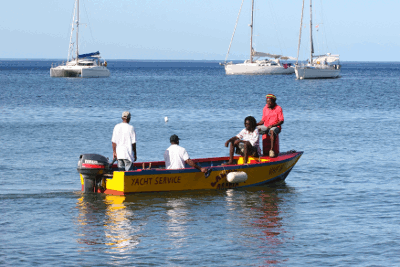

The best way to see an island is with an island tour, so that's what we did. We started early Sunday morning with a trip up the Indian River where our guide “Monty” paddled us quietly up the river, stopping from time to time to show us different birds, fruits and trees and even an Iguana. At the top of the river we were let off to go exploring for a couple of hours. We wandered through the rain forest and walked through a banana plantation, before going back to the river where Nick and Chelsea went for a swim. Despite the frequent rain showers, which soaked us for 10 minutes at a time the weather was perfect – not too hot and not too cold.
Back from the tour, we wandered through the main street on a whim until we heard the sound of singing. Being a Sunday - it was church. Loud and as only islanders can do it. Unable to resist the opportunity to experience an island church we quickly dusted off our muddy trekking clothes, tidied up our hair and then tentatively crept up the stairs to sneak into church. Once in, it was obvious that we weren't going to get in without being noticed; we were the only white people there.
The Church service was good and very lively and afterwards we were introduced to many people who were excited to hear of where we came from and what we were doing. Cheryl in particular hit it off well with one young local girl who attached herself and wouldn't let go. When it was finally time to go, her mother almost had to prise the pretty little girl from Cheryl as she really didn't want to leave.
We learned quickly that on Sunday almost everything is closed. We walked from one end of town to the other, trying to find somewhere open for lunch. Finally, just as we where we were about to give up, we discovered a small bar type establishment that seemed to be serving food. I went inside and asked about meals. I was told I could have a choice of fish, chicken or pork for lunch, but no menu. Each dish had the same salad and vegetables and all were EC$13.00 (US$5.20) each. We were hungry and the price was right, so I ordered lunch for the five of us. Just then Cheryl came in and said that she was unsure of the “quality” of the establishment. As I looked around to where she was pointing I noticed that there were many paintings of girls wearing very little and in, shall we say, interesting positions! We were just being shown to a table under one such painting, and I was more than a worried that a “show” might soon be starting, so I asked if we could sit outside on the little veranda. The owner bemusedly set up a rickety little table for us outside and we enjoyed a fresh meal. River Cruise Sunday sunrise, Church Sunday morning and Sunday lunch at a Strip Club – what a day! The following day, we booked an island tour with a guy called “Uncle Sam”. Along with an Aussie boat called “Tehani-Li” and another boat we met in the harbour called “Safari”, we all but filled
Eating the local food - The Caribbean Delicacies
Whenever we go somewhere new, we always try to buy the same sorts of foods as the locals. There's two reasons for this. Firstly because part of the experience of sampling different cultures is eating the sorts of foods they do, and secondly, because it's generally the cheapest way to eat!
We had been really looking forward to arriving in “the tropics” and feasting on delicious, fresh, juicy tropical fruits... and we were not disappointed! As we expected, the pineapples, mangoes, papaya (pawpaw), bananas, guavas, coconut & passionfruit were the best we'd ever eaten, available in abundance & cheap (if you bought it where the locals did!). Some surprises were the starfruit, dessert figs (a type of banana with an almost strawberry flavour), the local grapefruit (which are really sweet – not at all like the ones we buy back home and have to drown in sugar to make them palatable!), and an odd one the locals call “apricot”. This last one might have the same name as the fruit we know back home, but it was about the size of a rockmellon, had much firmer flesh than our apricot, and had two large seeds inside. The jury is still out on whether we would try this one again or not! The most fun would have to be the coconuts. Nick and Steve were in their element, tearing the husks off and “smashing” their way into them using a hammer and screwdriver in the cockpit of Connect4.
Mum and I were also keen to have a go at cooking some of the local vegetables. In the back of our cruising guide, the author lists a number of the local vegetables & root crops and suggested ways to cook them. We had a ball at the fresh produce market in Portsmouth, where the local ladies were very happy to help us identify and name their produce, and suggest how they would cook it. We bought breadfruit (a large, round, green bumpy-skinned fruit, which you can treat much like potatoes), Christophene (shaped like a large pear, with shallow ridges, either green or white skinned, which once cooked we decided was similar to zucchini), and plantains (which are like bananas, but have to be cooked before eating and are used as a vegetable). We also bought whole roasted cocoa-beans & whole nutmeg to grate, together with vanilla bean, and cinnamon sticks to make a delicious hot chocolate drink.
At the end of our successful shopping trip we even bought a refreshing drink of coconut milk, straight out of the freshly-macheted green coconut!
Cheryl
the little mini bus. We drove north along the coast to the Carib Indian settlement where we met a number of Carib Indians selling their woven baskets and other handy crafts. It appears they make a living as a tourist attraction, selling what they make. I spoke to one senior lady who was weaving a basket and heard that they are a diminishing group of people. Sadly, they're the last remaining Carib Indians anywhere in the Caribbean, but their numbers are diminishing rapidly due to their youngsters moving away from the settlement, marrying people outside the settlement and wanting a more western lifestyle. Sad to say, in a couple of generations there won't be anymore Carib Indians. As we drove around the island, we saw so many fruit bearing plants grow in abundance. We saw Paw-Paw, Mangoes, Bread-Fruit, Passion fruit, Pineapple, Coffee, Cocoa, Grapefruit, Oranges, Guava, Banana, Plantains, Desert Figs, Christophine, Coconut, Sugar Cane and many others, all growing in abundance. The driver even stopped on the road side and gave us some native cinnamon which smelt delicious.
When we booked the tour, the driver told us that he was at our service for the day and he'd take us anywhere we wanted to go. He gave us advice on the best places and helped us find some of the special, out of the way places. For this reason, probably the highlight of the whole tour was going to Spani Falls. Most of the cruise ships bypass these spectacular water falls because they require a walk into the park and as Uncle Sam stated with a dig, most cruise ship passengers don't like walking. On the way to the water falls, we walked through a magnificent rain forest that was so dense that at times it blocked the sunlight from shining directly through its canopy.
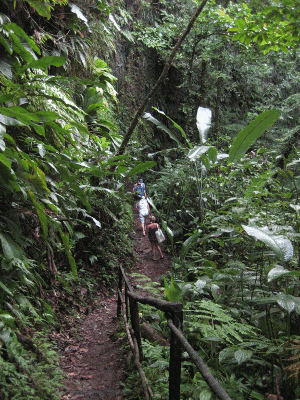
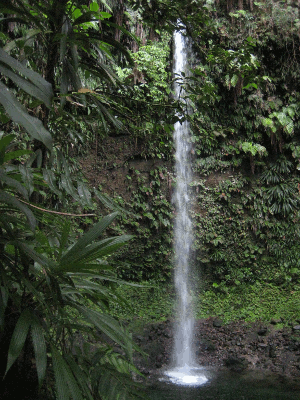
Everywhere we looked was lush and green and filled with the scent of the various plants and ferns. Everywhere we looked, everything was alive and thriving in this beautiful Garden of Eden. We heard the roar of the water falls before we got to them; the sound of the crashing and falling water is hypnotic and makes you want to run to it. As we got closer the air turned misty and all the plants and rocks around us were permanently covered in a soft dewy mist of water.
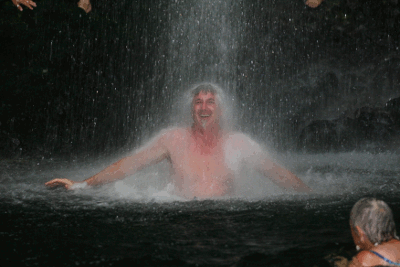
When we laid eyes on the waterfall, it took our breath away. There in the middle of a small break in the rainforest, on the side of a cliff, for the rainforest grew thick even up the side of the cliff, was a pure white spout of water gushing out of the forest and crashing down the cliff into the rock pool below. The waterfall would easily have been a hundred metres tall and the sound of the falling water reverberated through the rainforest, droning out the other sounds of the forest. Since we were the only people visiting the falls at the time, we all decided to get in our bathers and go for a swim. The water was cold, but not unbearable, but the pleasure of swimming in a waterfall pool
surrounded by lush rain forest is a joy to be experienced. Trying to stand under the actual waterfall was another thing entirely. We all tried, but the force of the water falling on your head and back threatened to drown you under the water as you were slowly pummelled into oblivion by the weight of the falling water – still we tried. Spani falls is actually two waterfalls. Uncle Sam explained it as a male and female waterfall that unites deeper into the rain forest. We couldn't resist the temptation to hike over the spine of the hill to the second and less frequented rainforest waterfall. The walk was a little precarious and we were glad that someone had strung a rope between the trees in the most dangerous places so that we at least had something to hold onto. The path on the side of the cliff was narrow and the ground was wet, steep and slippery. In Dominica there aren't any safety standards, so we were on our own; the only thing separating us from a 50m fall was our ability to hang onto the trees and the rope where it was attached. We were all more than a little relieved when we made it safely to the second falls. These were a lot more secluded and while not quite as large, were equally impressive. We had a short swim in these second falls and tried to stand under the falls again, with similar results.
Back at the mini-bus, we drove to a beautiful little restaurant for lunch and enjoyed a fare of local foods before heading back to town and the boat, exhausted but happy for the experience.
A couple of days later, we arranged for a driver to drop us at the Syndicate Forest / Milton Falls walk so that we could explore some of the rainforest ourselves. We were dropped deep in the heart of the island and were rewarded with a breathtaking rainforest walk that took our breath away at every turn. The forest was so dense and lush and the trees so tall and intertwined that you felt like you were walking through
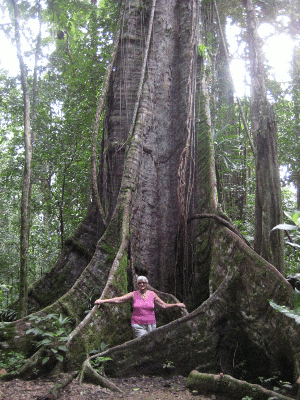
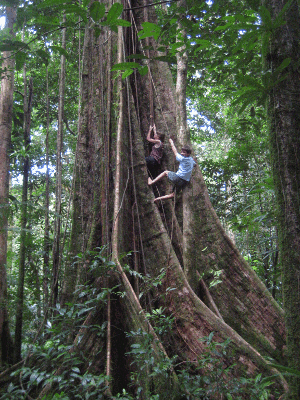
the heart of a living being. The walk took us to the very edge of a vast cliff drop off, and even then the forest grew out of the side of the cliff. The walking trail meandered for a couple of hours through the heart and soul of Dominica's country and we tried to soak up every minute knowing that we'll possibly never see anything like this again in our life. The rainforest was beautiful and unspoilt.
From the Syndicate Forest we walked to Milton Falls. The walk in was very muddy and slippery and even included a couple of creek crossings, but although there were times when we thought that not all of us would make the walk in, we all arrived safely and were rewarded with a view of an amazing waterfall. Looking up into the waterfall you could feel the reverberations of the water hammering down the rocky cliff and into the pool at the bottom and it shook you to the bone.
We walked out of the falls and back onto the main road where we met a local farmer who proudly took us around his property, giving us samples of each of his fruits and then picking a large bag of fruit for us to take back to the boat. He even cut some sugar cane from his plantation and after stripping it, gave us each a piece to chew on. We'd crush the sugar cane in our mouths, sucking the oozing syrup from the woody insides then spit out the remainder of the pulp. In this way we were rewarded with a beautiful fresh sweet syrup that tasted nothing like we expected, but was actually quite refreshing and sweet tasting, without being too sickly sweet as we'd expected.
Saturday 5th February 2011
We moved the boat down the coast to the capital of Dominca, Roseau so that we could snorkel on Champagne Reef. This reef is very close to some volcanic activity and as a result there are a number of hot water vents in and around the reef. Additionally, and perhaps this is what makes it so spectacular, is the fact that air bubbles up from the sandy bottom which makes you feel like you're swimming inside a champagne bottle. The feeling was amazing and even a little eerie because you can hear the noise of the bubbles coming out through the sand and every now and again you hear what sounds like a groan from deep beneath the bottom.
We saw all sorts of underwater creatures, including a barracuda, but the most impressive was an octopus. I first spotted him when he was camouflaged onto a reef. He sat still for a while watching me, while I floated nearby watching him, a bit of a stand off. Eventually he realised I could see him, so he quickly made off across the reef to settle in the crack of another rock. By this time, I'd called over the rest of the family and we were all floating around watching him make his way from rock hiding to rock hiding. Eventually he went off for a swim to another part of the reef, with 4 eager Aussies in hot pursuit. He settled on another rock and played the invisible game until Nick dove down and got a little too close to him at which time he blew himself up as large and white as he could make himself. Nick got the hint about a quarter of a second later and stopped his approach mid stroke then quickly scampered backwards, fins and arms flailing.

Sunday 6th February 2011
“One last trip to the southern highlands of Dominica, and then we'll leave”. That was the thinking. Dominica is so beautiful that we couldn't resist another trip inland to see the rainforests and the waterfalls. This time we went on a trip to see Trafalgar Falls. These are probably the most spectacular but also the most touristy of destinations in Dominica.
Now you may not know it, but Pirates of the Caribbean II was filmed almost entirely in Dominica and all the way around the island we were pointed out places that were involved in the filming. At one stop I got to swim up a gorge that Johnny Depp once swam in. How important did I feel eh? – I'm never washing my shorts again! If you remember in Pirates of the Caribbean II, just after Captain Jack Sparrow escaped from the natives by rolling down the hill in the big wooded basket, he jumped into a gorge and was swept away as the natives stood over the top and fired arrows down on him. We got to swim in the same gorge. Although the water felt like it was just half a degree above totally freezing, the four of us swam up the gorge and around the winding passages. As we neared a narrow part where there was a small waterfall, the current picked up and we found our progress slowing more and more. About 10m from the small waterfall, there was a small ledge that I thought I could stand on if I could get to it.
As I approached the ledge the gorge narrowed even further and as I tried to swim to it, I felt like I was just standing still. In actual fact, I was standing still even though I was swimming with all my might. After what felt like eternity of struggling I felt my strength draining, so I drifted back and found a footing to rest on. My second attempt was more determined and although it was very hard going, I finally managed to get a hand on the rock ledge and pull myself out. Once I was on the ledge, I noticed Chelsea bravely trying to swim the the ledge. The water was flowing pretty fast and she valiantly swam with all her might. I jumped back into the water, holding tight to the rock with one hand and reaching out to her with the other. I grabbed her hand as it came over for another stroke and heaved myself and her back to the rest of the little rock ledge. From the rock ledge, we caught our breath and watched as the water cascaded over the rocks and through the narrow little gorge.
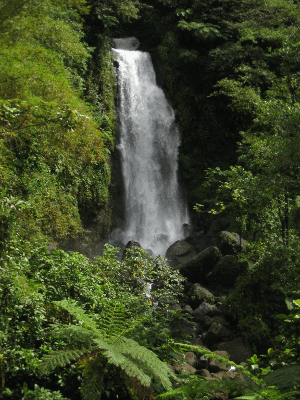
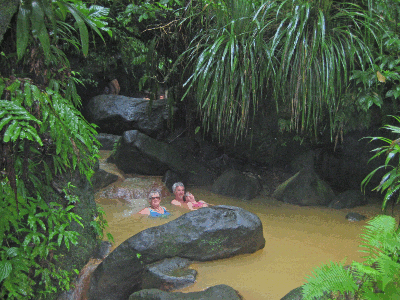
From here we went to Trafalgar Falls. We hiked the short walk down to the waterfall which was probably the most breathtaking waterfall we've ever seen. While the falls themselves were spectacular, the fun for us was in swimming in a little warm spring that was just off the side of the falls. The water was very warm and you had to position yourself in the right part of the stream, where the hot water mixed with the cold water until you found just the right temperature. Off to one side of the hot stream was a little hole in the rock that formed some semblance of a natural water slide down through the rock and out into the pool below. The kids (and adults) amused themselves here for a while, sliding down through the hole in the top and appearing in the rock pool below.
We've all seen the movies of the magic island where steam is belching out of a how steam vent in the middle of the tropical forest. Yep, we'd seen it too, but never in reality until today. As we were walking across a bridge, we looked up river and saw an incredible sight. There not a couple of hundred meters away from us was a hot water spring flowing into the river. We couldn't see the spring for all the steam and clouds of smoke that were continuously belching out of the side of the hill. What an amazing sight.

Tuesday 8th February 2011
One year ago today we moved aboard “Connect4”. It was a cold and rainy day, the wind was blowing and everything we owned was soaking wet by the time we dragged it from the taxi to our new boat. The boat felt unfamiliar and cold but we were excited to be moving aboard. We had nothing and we knew nothing, but excitement and the thrill of an adventure carried us through. And Our Dream. Our dream was what brought us half way across the world to crawl aboard an unfamiliar yacht. Our dream for quality family time and a family adventure that would bring us closer together carried us through the times when we would have otherwise given up. We've covered some miles in the last year, and while it doesn't feel like we've been gone very long at all, when we look back, we've achieved so much in the last 12 months.
Sometimes when people set out on an adventure, their dream turns into a nightmare and they end up being a slave to completing it. For us, the journey has always being the adventure, not the destination. We've a goal of sailing all the way back home to Australia, but we've always been realistic too.

Having never lived on a yacht before, having never even chartered a yacht for a holiday, having never even sailed a yacht this large before, we tried to be realistic about our expectations. We agreed that we'd sail along the coast of Turkey until we felt confident to sail further. We agreed that we'd sail through the Mediterranean and when we got to Gibraltar, we'd decide if we felt confident to go further or not. If we didn't want to go further, then we'd turn around and complete the year in the Mediterranean, sell the boat and fly home. We agreed that if we felt up to crossing the Atlantic, we would. Then based on how we handled the Atlantic crossing, we'd decide if one ocean was enough or if we felt capable of sailing across the Pacific also. If we crossed the Atlantic and got to the Caribbean
and decided we didn't want to cross another large ocean, then we agreed that we could sail a season in the Caribbean, take the boat up to Florida, sell it, then fly home, having had a great adventure. We also agreed that we would stick out this dream for 12 months and then reassess it. If at the end of 12 months, any of us decided we wanted out, then we'd sell the boat and fly home, having had a year off work and having had a year of family adventure together. Today was the 12 month mark.
We moved onboard an unfamiliar boat in Turkey and spent months making it our home. I spent hundreds of hours rewiring electrics, repairing systems, installing new equipment and making our boat something that would be capable of taking us safely across a world of oceans. We learned how to sail our boat, we learned how to anchor our boat and we learned her limits and what she likes and dislikes. We gave her a name and we slowly turned her into our home for the next few years. She became part of our family.
Today, the one year mark, was a turning point in our adventure. Today there was no hesitation in deciding that our family was up for the adventure and that we're happy to continue. Sure there's been times where any or all of us wished we were anywhere else but stuck on a boat. We've had 'ups' and 'downs', but if it weren't for the 'downs', then we'd never truly appreciate just how good the 'ups' are. The 'downs' have shaped us and made us pull together even harder when there's been nobody else but ourselves to get us through. The pressure of working closely together has caused arguments, but it's also made us understand each other better and learn how to work together more effectively. Through it all, our family is still happy sailing. We're capable of sailing through the Pacific. We're enjoying ourselves. We're having an adventure and we're going all the way to Australia.
In the months that we were in Marmaris Yacht Marine, preparing our yacht and listening to friends talk of all the out of the way places they've been to, we came to realise that our two year plan was grossly short. We talked and weighed things up and decided to extend our trip one additional year so that we could spend a whole sailing season in the Caribbean, exploring the islands. The plan was to spend a season in the Mediterranean, a season in the Caribbean and finally a season in the Pacific before coming back home to Australia. In total we'd have been away for three years. We worked this plan out the best we could and thought we might be able make our savings scrape through to a third year. Sadly though, we've come to realise that we just don't have the savings to permit us to take a third year off. It was a painful decision to make, and a disappointing one for Cheryl and I, but we've had to be realistic. Everyone told us, sailing takes a lot more money than you budget; in our case it's been painfully true. We've basically spent all our money we put aside for a third season, so now have decided to transit the Panama this March and enjoy our second season in the Pacific. The journey plan went from two years to three years, and now back to two. In one respect it's disappointing, but in another we have to remind ourselves of how fortunate we are to even be able to take a couple of years off, to enjoy an adventure of this magnitude. We have to remember that the adventure is a journey and it's not so much the number of days we have but rather the number of adventures we pack into the days we do have.
We may not have all the modern conveniences and perhaps we don't have showers as frequently or as long as we'd always like. We might not have a very large fridge and we sometimes have to ration our electricity, but as we travel the Caribbean islands we DO have lots of really cheap, sweet and fresh fruit. Mangoes are a rare treat in Adelaide and the ones we get there don't taste anything like the ones we've been eating here. Here's the family enjoying a feed of fresh sweet mangoes.
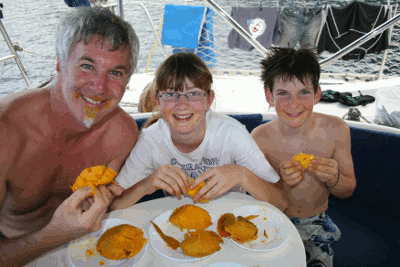
Friday 11th February 2011
Today, as I type, we're heading south down the coast of Martinique. We had a few days in Saint Pierre, but are now heading towards the capital city of Fort de France.
Saint Pierre was an interesting town, built on the ruins of the old town that was almost totally destroyed when Mount Pelée erupted and wiped out the entire city. Prior to the terrible explosion on the 8th May 1902, Saint Pierre was a thriving, bustling town of approximately 30,000 people and was the cultural, social and commercial town centre of Martinique. Some called it the Paris of the Caribbean. The island was extremely wealthy because of the plantations which made cocoa, rum, sugar and coffee.

You wonder how unpredictable the volcano must have been to explode and wipe out the entire city without warning, however it appears that the city had plenty of warnings, but chose to ignore them. Minor rumblings started occurring as early as April and sometime before dawn on the 2nd of May a fairly major eruption occurred that covered the city with enough ash to kill a number animals in the city. If this wasn't enough of a hint, later in the day a planter with an estate in the south of St Pierre was inspecting his crops with a party of workers when they were all swept away by an avalanche of boiling hot volcanic mud. On the 5th May, the whole of Guerin Estate was destroyed by a vast 30m high wall of boiling mud, lava and gasses.
With all these warning signs it really makes you wonder why nobody evacuated the city! This may sound like a cheap plot from “Jaws” but … The new Governer Mouttet had been on the island for less than a year and with an upcoming election and pressure from the planters not to call an evacuation because of the financial losses they would suffer he was reluctant to do anything that could be considered unpopular. So instead of having a backbone and making the call, he put a committee together that was responsible for monitoring the volcano. The people in this committee published comments to the local newspaper , “Les Colonies”, persuading people that there was no real risk and no danger to the residents. Sounding typical? A few people didn't listen to the propaganda and left, however most residents stayed.
Some people were on their way to St Pierre for the Ascension Day church service on the morning of the 8th May 1902, when they saw heavy red smoke from the volcano descend on St Pierre. At 8:02am the side of Mount Pelée facing St Pierre glowed an eerie red and burst open, releasing a gigantic fireball of superheated gas that flowed down over the town. All that remained when the smoke cleared was smoking ruins! It's estimated that, with the exception of only one man, approximately 30,000 people were burned to death in the explosion. Cyparis was imprisoned for murder, and was in a stone prison cell. The explosion was so intense that even the twelve ships moored in the bay were destroyed at anchor.
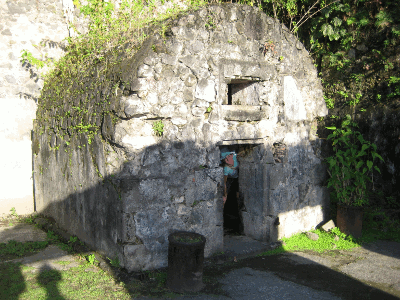

Martinique, like so many of the other Caribbean Islands celebrates Carnival. Carnival isn't just a one night thing, but rather has a big lead up with different activities and parades in the weeks leading up to the big parade and party day. While we were in town earlier today we were given a flyer advertising a parade and various events that were happening in the lead up to their Mardi Gras. Not one to pass on a parade, we eagerly ventured ashore and found the waterfront roadside transformed into a city of little stalls selling all sorts of drinks and snacks. Along the main route, people were gathering, people watching people while they waited for something to start.
The parade was loads of fun and it was very easy to get lost in the excitement of such a colourful environment. The music was so typically Caribbean and the atmosphere was electric. There were fire breathers and dancers, drummers and various bands. The parade was casual but so inviting. There were no lines marked to keep people back, there were no police patrolling. People stood on the side of the road without problem and as their favourite band or parade went by they would step off the kerb and join in at the back of their band, dancing and singing as they made their way, with the parade along the street. In this way it wasn't unusual to see twenty or thirty people following any one parade along the street.

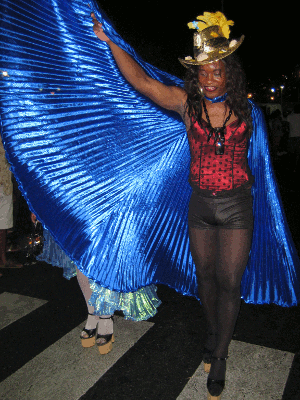
In any parade there's always a surprise package and there was no exception here. We saw some beautiful women walk by and then we saw these! Do you notice anything wrong with this photo? Look closely – you'll notice something out of place. Do you see it? Nick was totally shocked and couldn't quite place these “Lady Boys” as their called by the locals. One smiled at him and he quickly shrunk back behind Cheryl. Mind you, at over 185cm and on platform shoes they're a pretty intimidating sight.
Martinique is a French island that's very built up and could be a city in almost any place in the world. It's not been our idea of a Caribbean island, but then again, I guess I was expecting thatched huts and palm trees on every island so it's probably my own fault. It's funny how you get an idea on what you think a place will look like, and when you get there, you realise you were wrong. All the while we were in the Mediterranean, I was dreaming of white sand beaches, swaying palm trees and beautiful blue seas. I guess I was dreaming of the South Pacific. Most of the places in the Caribbean are just like any other place. Don't get me wrong, they all have their unique look and feel, their own characteristics and things to see and do. But … they all drive cars, they live in apartments and they have high rise buildings. Most of the young kids have Reebok sneakers brand name clothes. They have pubs and bars that charge over the top prices for things and they even have taxi drivers who want to rip you off - just like home! Perhaps what seems to be missing is the character, the identity of the island. Dare I say that many of the Greek islands we sailed through had retained their character and lifestyle despite the modern world revolving around them. Sure they all had internet, satellite TV and the mod-cons, but despite this they seemed to still be individuals with their own sense of identity. Here, as in many of the Caribbean islands, the people are no different to any mainland city in the US, or France. Perhaps I'm being too harsh in my opinion, but that's just how I feel right now.
Sunday 13th February 2011
Today we said goodbye to “Ginnie”. Cheryl's mum, has been part of the “Connect4” family for a couple of months now and she's experienced so much of life onboard. When she first arrived she was introduced to life on the hard as we completed our anti-fouling. We thought she'd have run after that one, but to her credit she stayed and persevered. Once we relaunched, she slowly learned that life aboard isn't all beer and skittles on the beach at sunset. Dingy trips were the bane of her existence as she sometimes had trouble getting in and out of the dingy. Having perpetually wet feet and soaking shoes were a part of her existence.
“I'll be glad to have dry shoes for a change, and I'm looking forward to a flushing toilet and a shower with unlimited hot water” - Ginnie Thompson.
She learned that we walked a lot more than people with a car do, and came to understand that simple tasks like food shopping take on a whole new challenge when you have to get the groceries back to the boat. But despite the hardships, she enjoyed seeing new countries for the first time and came to appreciate the
difficulties of foreign languages and foreign places and foreign cultures. She sailed with us from the Canary Islands down to the Cape Verdes and had a Christmas in a strange land. To her outstanding credit, she sailed with us the 2400NM across the Atlantic and shared in our excitement of landfall after 17 days at sea. She was with us when we caught fish and watched the dolphins frolicking in the waves at sunset. We saw a whale and we took her swimming on reefs. The whole purpose for our journey is to spend time together as a family and to experience an adventure. We're privileged to have Ginnie share in our adventure. But like all wheels of life, they turn and now she's moved onto the next part of her adventure and is no doubt going to enjoy the finer things in life like flush toilets, long hot showers and dry feet. She's off to Paris with her sister Ann, and we're back to just the four of us again.
Hey, just a little side note. If you've been reading this blog so far and you have a second, have a look at the cool map we're in the process of making. It's to the left. Under the “About Us” section is a link to “Route Map”. This will give you a cool satellite map showing where our route has taken us. Also, we'd love to hear from anyone whose stumbled across our blog site. Over the last 6 months the number of hits on our pages have increased exponentially and it would be great to hear whose reading our stories. If you have a minute, please check out the new “Contact Us” page and drop us a little note. Seriously, we'd love to hear from you.
Tuesday 15th February 2011
We pulled anchor early this morning and headed out from Fort de France, en-route to Bonaire. This is approximately 450NM and we should do it in a little over 3 days with good weather. It's funny how quickly you settle back into the sailing routine. I was feeling quite comfortable at anchor and not really wanting another multi-night journey. However once we unfurled the sails and were on our course, that feeling of adventure and going somewhere kicked in and now I'm quietly content to be sailing on the winds once again. After so many days of sailing over the last year, being out on another passage feels like putting on a comfortable pair of old jeans. It just kind-of fits and feels right! It's hard to explain, but all the rush of the day and the timetables of society seem to fade as the land recedes from sight and our own routine of life aboard kicks in. You have time to think, time to relax and chill out. Time to contemplate. It's a nice feeling knowing that the only things that matter out here are all contained within my 12.94m x 6.90m world.
To date we've sailed over 6800NM and while some people (who obviously don't know much about sailing) look at us and think we know it all now, we beg to differ. To be truthfully honest, we still feel very much like “newbies” - we really don't think we know much. Perhaps this is the reason we've survived so long - you see, when you know that you don't know everything, you take great care to make sure that you've done everything you do know; and well! I always check all systems before leaving, I carefully plot our course and double check the route and try to do as much as I can to stack the odds in our favour. We even wait patiently for the winds that will give us the smoothest sail within our envelope, rather than the winds that might get us there the quickest. And even after all that's done, we're very cautious sailors. We reef early and deep and follow that adage that “If you're thinking about reefing … do it!” We look up to lots of other sailors who have been sailing for a lot longer than us and in much bigger and luxurious boats, so it's quite refreshing to hear when one of these “revered” people stuff up.
We were having some evening drinks with friends on their yacht, exchanging stories and having a good laugh over some of the silly things we've all done when he came up with this pearler of a story. There was this guy, who obviously will remain nameless to protect his family … He'd just bought a nice, rather large (well significantly larger than ours) catamaran and was sailing it back home. He'd programmed all the way-points into the chart plotter and was relaxing en-route when all of a sudden he hears an almighty crash and the boat came to an abrupt halt. As he ran out on deck to see what had happened, he noticed a large red marker approximately 3m in diameter and a couple of meters high, jammed under the trampolines of the catamaran, wedged between the two hulls. Turns out this guy had programmed a way-point on top of a channel marker and then arrived at that way point. Perhaps he planned to pass close to the channel marker, perhaps he mistakenly transcribed the coordinates of the channel marker rather than his way-point; I guess we'll never know – it's just amusing to hear stories where people have muffed up bigger than we have. It would have been am amusing sight though, to see a nice new catamaran mounted atop a bright red channel marker.
Saturday 19th February 2011
I'm in Paradise! Bonaire is such a beautiful island! We arrived Friday early afternoon after a good three day sail in light winds and flat seas. “Connect4” isn't a fantastic light wind sailor, especially when she's wearing her “cruising outfit”; but this time we sailed from Martinique with only a couple hundred litres of water onboard, not too much in the way of supplies and then around 15 hours out from Martinique we hit a nice 2 – 2.5 knot current stream that stayed with us almost the whole way to Bonaire. This current helped us maintain average speeds of 6-7 knots for almost the whole way.
Bonaire is a magnificent island, that's ranked as one of the top three dive sites in the world. The whole island is sanctioned as a reserve. All boats have to use the mooring balls provided because anchoring anywhere on the island is strictly prohibited. We're moored just off the main town of Kralendijk and have a beautiful reef drop off five meters off the back of our transom. Oh, did I happen to mention that this place is beautiful?
Monday 28th February 2011
We're preparing to leave Bonaire and looking back on our last 10 days I know it's going to be hard to describe the experiences and the friendships we've made here. When we arrived on Bonaire, we looked around to see if there might be a local church we could go and visit. We picked one out of the local newspaper and Sunday morning we got dressed up in our best shore clothes and walked off to church. We must have been a sight at the church as we were one of very few “white” families there. The service was fantastic though and we thoroughly enjoyed singing their songs in English, Dutch and Papiamento. Papiamento is the island's local language, and has a number of similarities to Spanish. This helped me with the pronunciation of the foreign words although I still probably sang just as badly. Dutch on the other hand didn't work at all. My tongue refused to follow the music and got all tripped up on words that had too many “J's” and “K's” all next to each other. I found I was always at least a line or two behind after I'd managed to rescue my tongue. I guess you can't be expected to sing brilliantly in every language. The service itself was really enjoyable, and again it was in all three languages. The Pastor spoke in one language and an interpreter interpreted to the second language. Every now and then, the Pastor would switch language and so would the interpreter. This meant that two out of the three languages were always being spoken and when it came turn for one to be missed out, you just had to sit there and wait until your turn came around again. This was a new experience for us but highlighted the effort the church makes to preach the gospel in everyone's local language.
We met the Pastor, his wife and two children and as Tuesday was his day off we arranged to catch up with Romero and his wife Tamara aboard “Connect4” for coffee. As cruisers we often meet new friends, but don't really get to know them very well before we move on again. Spending time getting to know new friends a little closer was really special and we all had a great morning.
Bonaire is a beautiful island, renowned for its reefs and aquatic life. Most of the great underwater spots in Bonaire are a little deeper so are better for SCUBA divers, however there's about a dozen sites around Klein Bonaire, which is the little island off the west coast of Bonaire. We dingied over to the island one day and picked up a mooring ball then went snorkelling along the reef. The reef is a large drop off and we swam for a couple of hours along its edge, taking turns diving and exploring the beautiful colours of the vividly alive reef. We saw so many different types of fish but sadly no turtles. Turtles in Bonaire are a highlight. Because the whole of the island is a giant reserve, turtles and all marine life are protected. This makes it a great place for turtles to come to live and breed. At turtle hatching season, the locals delight in watching the new born turtles dig their way out of their sandy nest and make their way down to the water. We've heard lots of people tell us about the magnificent turtles that are along the reefs in Bonaire, however we didn't see any.
We'd read in the newspaper that the local turtle protection group called the “Sea Turtle Conservation Bonaire” STCB were having a sea turtle information night at Captain Don's Habitat. Don was a famous figure in Bonaire's aquatic history; having being the first diver to rally to have Bonaire turned into a Marine Reserve and to put Bonaire on the map as a world famous dive destination. Over the years Don has worked hard to preserve and to protect the reefs around Bonaire and is a highly respected figure in Bonaire. We went along to the sea turtle information night and met a vibrant character called Leo who talked with enthusiasm about the local sea turtles and their habitat. The two main types of turtles that frequent Bonaire are the Green Turtle and the Hawksbill Turtle. The Hawksbill turtle is easy to identify because it has serrations along the rear of it's carapice (upper shell). The Green turtle is named not because it's green, but rather because in days gone by it was a superb eating turtle and was renowned for it's green flesh. In Dutch, the Green turtle is called the “Soup turtle”. We learned many fascinating facts about turtles from Leo. One interesting point that I learned was that when turtle eggs are laid the turtles inside aren't sexed. In humans, at the point of conception the sex is determined and the foetus grows as either male or female. Turtle eggs are laid and the temperature of the egg is what determines if it will turn into a male or a female. It's amazing that less than one degree in temperature swing will make all the eggs hatch either male or female. If the eggs are kept warmer then they will hatch female. If the eggs are kept a little cooler then they'll be male. “Hot Chicks and Cool Guys” is the way to remember it when it comes to turtle sexing. The mother turtle will lay the eggs in a location and at a depth so that the eggs will hopefully hatch 50:50 male and female. If you're interested in finding out more about the Bonaire turtles, check out www.bonaireturtles.org.
We wanted to take a day and drive around the island to see the sights, so we found a place that had a car for rent and booked it for in a couple of days time. We'd heard that car hire could be a bit of a problem on the island because it was high season and most car rentals were all booked out. After a number of “sorry – we have nothing” we were fortunate to find a place prepared to rent us a car for just one day.
Thursday came and we fronted up at the car rental company to collect our car. The hire car owner shocked me when he said that he had no car for us as he'd hired it out to someone else that morning. At first I was waiting for the punch line, but it never came. It took a moment for it to register! How could he do that to us? After we'd made a point of formally booking the car a couple of days earlier and even paying a $500 deposit I was stunned that something like that could happen. How could he do that? I kept my cool and asked him what he was going to do about it, since we'd obviously had an agreement to hire a car from him and he was now defaulting on that agreement. He replied, “I'll give the lady that accepted your booking a warning because she knows the policy that we don't hire cars out for just one day during high season and I'll let you use my telephone to ring a couple of other car hire places to see what you can hire – beyond that what can I do?”. I replied, “You agreed to hire us a car, I think you can find us another car to hire for the day!” We rang a couple of other car hire companies, but as expected, all were booked out, so I kept persisting. Finally he conceded that perhaps there might be a car we could hire. He took us outside to show us a small Suzuki Jimny that looked like it was dragged out of a car wrecking yard. The roof was torn and hanging down, the seats were ripped, the panels were all rusted through. The tyres were bald and there was a big section of the windscreen that was smashed like it had been hit with a falling coconut. Without much recourse if we wanted to hire a car, I told the guy that I was very disappointed with his offering as it fell a long way short of the car we'd booked. Since he had us between the proverbial rock and a hard place if we wanted any car we had no choice but to accept it, but I made it clear that I wouldn't pay the full $49 for the day. I offered him $35 for this wreck of a car and not a cent more. He grizzled something illegible and said that he never reduces the price of the cars for hire, and we could take it or leave it. He kind of had me at this point as we both knew there were no other car hire places with cars available for the day, so I pulled out my last card. I told him I wasn't from some cruise ship, and I wasn't from a resort here, but rather that I was from a yacht. I told him that yachties talk and share advice on good and bad places and if he didn't come through on his part of this arrangement then I'd not be able to say anything good to all the other yachties that might be visiting the island. This I assured him would cost him a whole lot more than the $15 he was unprepared to discount. He thought about it for a second, then said “wait a minute, there may be another option”. He went out the front and started up an old Jeep Wrangler and took off around the block in it. He came back a few minutes later and told us that we could have this car for the same price we originally agreed upon, even though this was a larger and normally more expensive car to hire. I asked him why he had to test drive the car first and he replied “A customer complained about some issues with the brakes, so I've not hired it out in a while” Great!!! We were hiring a car with a query about the brakes!!! His parting words were “Sorry about the misunderstanding”. “Enjoy your day but watch out for goats and donkeys; they're not covered by insurance”. This was going to be a great day – donkeys, goats and unhelpful agents.
We set off in our tired old jeep. The ignition was broken, so we had an isolator switch and a push button to start it with. The brakes … ahhh … The brakes were indeed suspicious! The bias on the brakes was far too heavy on the rear right wheel, so we constantly locked up the back right wheel anytime we tried to stop. Add to this the fact that the vehicle pulled violently to the left, which made us swerve toward oncoming traffic every time I jabbed the brakes. What a great combination! The steering reminded me of the old Massey Ferguson tractor I learned to drive when I was 10. On the farm, you could turn the wheel almost half a turn in either direction before the wheels responded, this vehicle wasn't a whole lot better! The kids were cramped in the back of the car, and since we only had a soft top, there were no sides. When it rained, which happened quite a few times in the day, they got wet.
We drove, or rather, guided our old Jeep around the winding island roads, admiring the coastline and reminding ourselves that the Jeep was still better that walking. We stopped at a flamingo conservation area and although we couldn't get close, we got to view a dozen or so beautiful pink flamingos in the wild.
Back in the car, we drove further around the coast the Washington-Slagbaai National Park on the northern end of the island. After a lunch, we walked through the park counting lizards (at least 200) on our way to the different sights that were marked. We saw a couple of natural fresh water wells and a large wall that was built hundreds of years ago. The thing that I found most interesting about the walk was that most of it was over coral, even though we were a couple of hundreds meters inland from the coast. At the rocky coast we saw a large blow hole that was spraying large amounts of water out of the hole whenever the waves came in. Nick couldn't resist stripping down to his bathers and standing down wind of the blow hole. The next wave that worked its way into the blow hole sprayed up in a large geyser and soaked Nick thoroughly.
On the way back to town, we drove around the southern end of the island and saw a rugged coastline on one side and salt flats on the other. We stopped the car at one point where we saw 20 – 30 flamingos close by, on the salt flats. They were a beautiful sight, made all the more startling by the contrast of the colour of the bright pink flamingos against the white of the salt flats. We watched them as they took flight and headed out to sea. These flamingos are the funniest creatures when you see them flying. They have long necks and long legs, the latter of which stick out straight behind them as they fly while the former stretch forward making them look like a flying stick. When you see 10 or 20 of these creatures flying in formation they look so funny that you can't help smiling at the oddity of them. There really are some funny looking creatures in this world!
Sunday we went back to church again, then had the Pastor, his wife and family join us onboard “Connect4” for an afternoon trip over to Klein Bonaire where we all went snorkelling before coming back to our now very familiar mooring ball. The snorkelling was fun even though we didn't see any turtles but the highlight of my day was just sitting with Romero chatting about life and learning about the issues and challenges of people on Bonaire. I spent some time sharing ideas and plans from the men's group that I'm involved with in Adelaide. It's interesting that anywhere in the world, men are facing the same problems and challenges of juggling work, with family, with their identity and the demands of modern society. Perhaps we both think the same way or perhaps it was that we both enjoyed talking deep, but it was really enjoyable to spend time with Romero.
A few days earlier I'd mentioned to Romero that we were heading to the San Blas Islands after Bonaire. The San Blas Islands are a group of 365 islands off the coast of Columbia that live in a very third world and primitive environment. We'd been told by some cruisers earlier that many of the older women on the islands make a meagre living by making and selling Molars. These are intricate shirts and articles of clothing that are patterned by sewing layers of different coloured fabrics together then cutting out the layers in between to make pictures or patterns. Unfortunately as the women get older their eye sight deteriorates and they can no longer see well enough to make their molars, so lose their income. We'd decided that as a family we wanted to contribute and try to do something to help these people. I asked if Romero could ask the church for donations of old glasses that weren't used anymore. On Sunday he asked people to donate any old glasses they had. Monday I was so amazed when I received a bag of no less than 15 pairs of different reading glasses. I also was given a couple of donations of money; one lady donated $10 and another man that I met in a little restaurant when I was downloading my last lot of emails for a few weeks donated $20. I was amazed at the generosity of the people here. We bought some fishing hooks with the $10 we received, as the islanders really appreciate steel fishing hooks. With the $20 we received, Cheryl went to the local optometrist and bought three pairs of magnifying glasses and after speaking with the optometrist and telling him what we were doing he donated another 5 pairs of prescription glasses that were from people who had placed orders but never collected.
Tuesday morning came and we checked out of the country, stocked up on food then in the afternoon we motored over to Klein Bonaire for one last dive. We were stopped and boarded by the Bonaire Coast Guard who checked our papers and passports before wishing us a good sail and departing. We tried to pick up a mooring ball near a beach that we we're told was frequented by turtles, however the local dive boat had tied himself to both the mooring balls and refused to give one up for us. With the afternoon creeping by fast and time running out, we motored around to another mooring ball, disappointed that we would soon be leaving Bonaire without seeing any turtles. We jumped into the water for a final swim on the beautiful reefs and found ourselves in the middle of a patch of jelly fish. Fortunately for us, while they did sting if they came in contact with your skin, they rarely stung and when they did it was not as bad a sting as we would have expected from an Australian jelly fish. Chelsea and Nick didn't appreciate the jellyfishes at all. Nick took a sting early on and it took a lot of coaxing to get him to keep swimming. Chelsea saw the jellyfish and no way through, so climbed up on my back! I was swimming along minding my own business, trying my best to swim between the jelly's when all of a sudden I had this lump grabbing at my rashy and climbing up onto my back! We swam a little and then it happened. Cheryl was the first to spot it – a beautiful little Hawksbill turtle swimming along the edge of the reef! It was a beautiful sight. We all gathered around him, forgetting our problem with the jellyfishes and focussing totally on this elegant creature as he made his way nonchalantly around the reef. I can't remember how long we followed him for, but it was an amazing sight. He wasn't scared of us, but neither would he let us too close to him. We must have looked a funny sight, the four of us swimming in circles around this little turtle as he made his way, foraging the reef for whatever he was looking for.
Eventually he made it clear that we were cramping his style, so he departed into the shallows. Nick and I followed him for a little while, but it got too shallow for us and in any case he'd given us the slip by swimming faster through the shallows than we could, so we returned to “Connect4” and set off on our 5 day sail to the San Blas Islands.